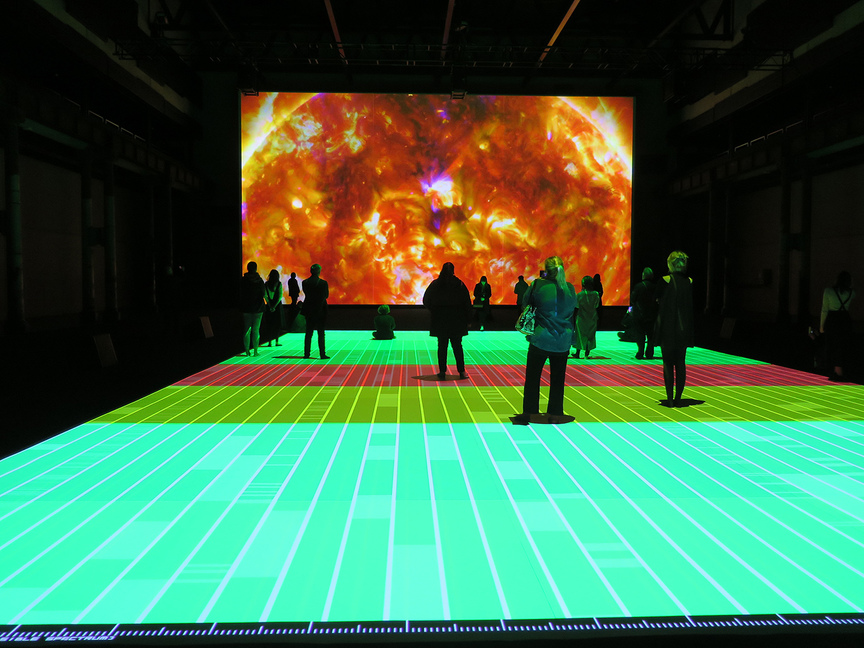
R
E
V N
E
X
T
Installation view of RYOJI IKEDA’s Micro/Macro, 2015, video projections, computers, speakers, with programming and graphics by Norimichi Hirakawa, Tomonaga Tokuyama, Yoshito Onishi and Satoshi Hama, dimensions variable, at Carriageworks, Sydney, 2018. All photos by Michael Young for ArtAsiaPacific, unless otherwise stated.
The popularity of Japanese electronic composer and visual artist Ryoji Ikeda is unquestionable. His works are much in demand. As of July 2018, there have already been showcases of his electronic wizardry in Paris, Moscow, Tokyo and Tasmania, among other places. In Hobart, his work Spectra (2013), with 49 searchlights shooting beams of light 15 kilometres into the sky, has become a permanent addition to the city’s landscape, courtesy of the enigmatic tycoon and art collector David Walsh, whose private Museum of Old and New Art is located just beyond the city limits.
“Micro/Macro,” comprising the 2015 audiovisual installation of the same name, was Ikeda’s third presentation at Sydney’s Carriageworks. His first, of Test Pattern (No 5) (2013), a fast-moving, large-scale melange of electronic sound and projections of computer-generated visuals, attracted a crowd of 42,000 visitors when it was shown for three weeks in 2013. His ticketed Superposition (2012), presented in 2015 at Carriageworks, involved two onstage performers communicating via Morse code while immersed in white noise and algorithmic imagery, and was inspired by “the mathematical notions of quantum mechanics,” according to the artist’s website. Micro/Macro, developed during an artist residency organized by the European Organisation for Nuclear Research (CERN) in Switzerland, follows the same line of investigation, but also incorporates Ikeda’s exploration of matter under the Planck scale, the smallest possible unit of measurement. The Carriageworks iteration will be Micro/Macro’s final presentation.
The two projections that make up Micro/Macro are in fact two separate works. Taking up a 20-meter-wide screen on the wall, one of the channels shows a sequence suggestive of movements through deep space, punctured occasionally by white specks that flash across the cosmos. The ground projection is roughly twice the size, and is of fast-moving patterns such as a scrolling grid and floating coordinates that accelerate almost imperceptibly into hysterical lines before morphing back into geometrical patterns that slide across the floor.
As I padded, sans shoes, through the darkened space at Carriageworks, bombarded by flashing lights, and deep, other-worldly sounds, I couldn’t help but think of the Music of the Spheres, an ancient philosophical concept that ascribed sound to the movement of celestial bodies—and perhaps there is much resonance between this idea and Ikeda’s cacophony in the attempt to articulate something that is beyond human perception or understanding. Though I wondered whether reducing the audience to a stasis of wonder by bombarding them with visual and aural information is enough to ask of a work of art, I sensed that Ikeda is driven by an innate obsession with the immeasurable flow of time and a personal desire to reach for the stars.
Michael Young is a contributing editor of ArtAsiaPacific.
“Micro/Macro,” is on view at Carriageworks, Sydney, until July 29, 2018.
To read more of ArtAsiaPacific’s articles, visit our Digital Library.





